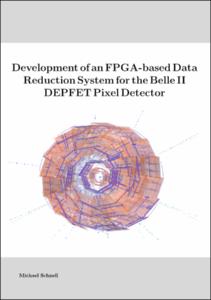Development of anFPGA-based Data Reduction System for the Belle II DEPFET Pixel Detector

Development of anFPGA-based Data Reduction System for the Belle II DEPFET Pixel Detector

| dc.contributor.advisor | Dingfelder, Jochen Christian | |
| dc.contributor.author | Schnell, Michael | |
| dc.date.accessioned | 2020-04-21T07:31:48Z | |
| dc.date.available | 2020-04-21T07:31:48Z | |
| dc.date.issued | 14.07.2015 | |
| dc.identifier.uri | https://hdl.handle.net/20.500.11811/6499 | |
| dc.description.abstract | The innermost two layers of the Belle II detector at the KEKB collider in Tsukuba, Japan will be covered by highly granular DEPFET pixel sensors. The large number of pixels lead to a maximum data rate of 256 Gbps, which has to be significantly reduced by the Data Acquisition System. For data reduction, the hit information of the silicon-strip vertex detector surrounding the pixel detector is used to define so-called Regions of Interest (ROI) in the pixel detector. Only hit information of the pixels located inside these ROIs are saved. The ROIs for the pixel detector are computed by reconstructing track segments from strip data and extrapolation to the pixel detector. The goal is to achieve a reduction factor of up to 10 with this ROI selection. All the necessary processing stages, the receiving, decoding and multiplexing of SVD data on 48 optical fibers, the track reconstruction and the definition of the ROIs, will be performed by the DATCON system, developed in the scope of this thesis. The planned hardware design is based on a distributed set of Advanced Mezzanine Cards (AMC), each equipped with a Field Programmable Gate Array (FPGA) and four optical transceivers. An algorithm is developed based on a Hough Transformation, a commonly used pattern recognition method in image processing to identify the track segments in the strip detector and calculation of the track parameters. Using simulations, the performance of the developed algorithms are evaluated. For use in the DATCON system the Hough track reconstruction is implemented on FPGAs. Several tests of the modules required to create the ROIs are performed in a simulation environment and tested on the AMC hardware. After a line of successful tests, the DATCON prototype was used in two test beam campaigns to verify the concept and practice the integration with the other detector systems. The developed track reconstruction algorithm shows a high reconstruction efficiency down to low track momenta. A higher data reduction than originally intended was achieved within the limits of the available processing time. The FPGA track reconstruction algorithm is found to be even three times faster than demanded by the trigger rate of the experiment. The used concepts and developed algorithms are not specifically designed for the Belle II vertex detector only, but can be used in different experiments. It was successfully tested on the low-level trigger for Belle II, using drift chamber information and showed a comparably good track reconstruction performance. | en |
| dc.language.iso | eng | |
| dc.rights | In Copyright | |
| dc.rights.uri | http://rightsstatements.org/vocab/InC/1.0/ | |
| dc.subject | data reduction | |
| dc.subject | DEPFET pixel detector | |
| dc.subject | strip detector | |
| dc.subject.ddc | 530 Physik | |
| dc.title | Development of anFPGA-based Data Reduction System for the Belle II DEPFET Pixel Detector | |
| dc.type | Dissertation oder Habilitation | |
| dc.publisher.name | Universitäts- und Landesbibliothek Bonn | |
| dc.publisher.location | Bonn | |
| dc.rights.accessRights | openAccess | |
| dc.identifier.urn | https://nbn-resolving.org/urn:nbn:de:hbz:5n-40586 | |
| ulbbn.pubtype | Erstveröffentlichung | |
| ulbbnediss.affiliation.name | Rheinische Friedrich-Wilhelms-Universität Bonn | |
| ulbbnediss.affiliation.location | Bonn | |
| ulbbnediss.thesis.level | Dissertation | |
| ulbbnediss.dissID | 4058 | |
| ulbbnediss.date.accepted | 15.06.2015 | |
| ulbbnediss.institute | Mathematisch-Naturwissenschaftliche Fakultät : Fachgruppe Physik/Astronomie / Physikalisches Institut (PI) | |
| ulbbnediss.fakultaet | Mathematisch-Naturwissenschaftliche Fakultät | |
| dc.contributor.coReferee | Desch, Klaus |
Files in this item
This item appears in the following Collection(s)
-
E-Dissertationen (4383)




